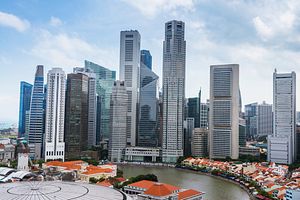Asia has made gains in its international competitiveness, but the global economic outlook remains cloudy, the World Economic Forum (WEF) has warned.
Releasing Wednesday its latest Global Competitiveness Report, the Switzerland-based organization said its host country remained on top for the second straight year, with the United States gaining two places to third. Yet Asian countries took three of the top 10 spots, led by Singapore in second place, while Japan climbed three spots to sixth and Hong Kong stayed seventh.
Singapore earned its high ranking for the fourth consecutive year, “owing to an outstanding and stable performance across all dimensions” of the index, including goods and labor market efficiency and financial market development.
Japan posted the largest improvement of the top 10 economies, aided by its edge in business sophistication, innovation, high R&D spending and talent.
However, the WEF said the world’s third-biggest economy suffered from “severe macroeconomic challenges” including its high public debt. It was also hampered by having the lowest female workforce participation rate in the OECD, although the report said “the country’s battle against deflation has started bearing fruit.”
Hong Kong earned praise for remaining “one of the most open economies in the world,” with high ratings for infrastructure, financial market development and market efficiency, although it was urged to improve on its higher education and innovation systems.
ASEAN nations also posted gains, with Malaysia rising four spots to 20th, Thailand up six places to 31st, Indonesia gaining four spots to 34th, and Vietnam up two to 68th, while the Philippines rose seven to 52nd, earning WEF’s praise as the “most improved country since 2010.”
China also advanced, gaining one place to 28th to remain the highest ranked BRIC economy. The world’s second-biggest economy posted gains in entrepreneurship and innovation, but was marked down for its “fragile” financial sector, governance and market restrictions.
“Trends are largely positive, but now is not the time for China to be complacent. The country is no longer an inexpensive location for labor-intensive activities and is losing manufacturing jobs to less-developed countries and even to some more advanced economies. China must now create the high-value jobs that will sustain the increasing standards of living,” the WEF said.
South Asia Slides
However, it was not a complete success for the region, with Taiwan slipping two places to 14th and South Korea down one to 26th. The WEF said the competitiveness gap between South and Southeast Asian nations “runs deeper than before,” with India placed the highest at 71st, down from 60th, followed by Sri Lanka in 73rd, while Pakistan placed 129th.
“Since 2009, the average [index] score of the South Asian Association for Regional Cooperation (SAARC) countries has stagnated,” the WEF said.
While rising up the rankings, five Asian nations were ranked below the 100th mark: Nepal (102nd), Bhutan (103rd), Bangladesh (109th) and Myanmar (134th).
New Zealand earned bragging rights over its neighbor Australia, with the Kiwis rising one place to 17th, its highest rank yet. Australia slipped one place to 22nd, continuing its downward slide since its best ranking of 15th in 2009, hampered by red tape and a “rigid” labor market.
“Australian businesses, year after year, have named the restrictive labor regulations the most problematic factor for doing business in their country by a wide margin,” it noted.
Reform Steps
While the WEF said the region’s challenges varied enormously, some common trends had been identified.
“For the most advanced economies, such as Japan, [South} Korea, and Taiwan, one common challenge is the rigidity of their labor markets. They must also set up an ecosystem that is better at creating truly disruptive innovations,” it said.
“For countries such as Malaysia, the goal is to transform the economy to become more knowledge-driven in order to avoid the middle-income trap. In China, more reforms and liberalization are needed to improve market efficiency, increase competition, and encourage a more optimal allocation of financial resources.”
For emerging Asia, the WEF said challenges included “addressing the huge infrastructure deficit and improving regional connectivity; reducing red tape, which will promote economic formality and entrepreneurship and reduce pervasive and deep-rooted corruption; and improving market efficiency by phasing out distortionary measures.”
“As the region’s poorest economies—such as India and Myanmar—are transitioning away from agriculture and developing a manufacturing base, they will need to create a sound and stable institutional framework for local and foreign investors and improve connectivity,” it said.
Global Economy ‘At Risk’
The WEF also had a warning for policymakers, calling for further structural reforms to boost growth.
“The health of the global economy is at risk, despite years of bold monetary policy, as countries struggle to implement structural reforms necessary to help economies grow,” it said, noting “uneven implementation of structural reforms across different regions and levels of development.”
“The strained global geopolitical situation, the rise of income inequality, and the potential tightening of the financial conditions could put the still tentative recovery at risk and call for structural reforms to ensure more sustainable and inclusive growth,” said Klaus Schwab, WEF’s founder and executive chairman.
The rankings are based on 12 categories comprising institutions, infrastructure, macroeconomic environment, health and primary education, higher education and training, goods market efficiency, labor market efficiency, financial market development, technological readiness, market size, business sophistication, and innovation.
For Asia, building on the region’s strengths while assisting lower-ranked nations to climb the scale is the key challenge for policymakers, should it seek to eclipse its more established rivals.

































